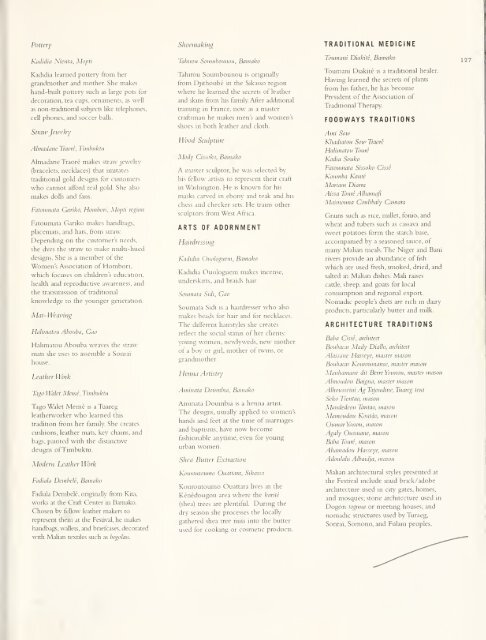SCOTLAND - Smithsonian Digital Repository - Smithsonian Institution
SCOTLAND - Smithsonian Digital Repository - Smithsonian Institution
SCOTLAND - Smithsonian Digital Repository - Smithsonian Institution
Create successful ePaper yourself
Turn your PDF publications into a flip-book with our unique Google optimized e-Paper software.
Pottery<br />
Shoemakiiig<br />
TRADITIONAL MEDICINE<br />
Kadidia S'ieiila, Mopti<br />
Tahirou Soumbounou, Bamako<br />
Toumani Diakite, Bamako<br />
127<br />
Kadidia learned pottery' from her<br />
grandmother and mother. She makes<br />
hand-built pottery such as large pots for<br />
decoration, tea cups, ornaments, as well<br />
as non-traditional subjects like telephones,<br />
cell phones, and soccer balls.<br />
Straw Jewelry<br />
Almadane Traore, Timbuktu<br />
Almadane Traore makes straw jewelry<br />
(bracelets, necklaces) that imitates<br />
traditional gold designs for customers<br />
who cannot afford real gold. She also<br />
makes dolls and fans.<br />
Fatoumata Gariko, Hcmhori, Mopti region<br />
Fatoumata Gariko makes handbags,<br />
placemats, and hats, from straw.<br />
Depending on the customer's needs,<br />
she dyes the straw to make muln-hued<br />
designs. She is<br />
Women's Association of Hombori,<br />
which focuses on children's education,<br />
a member of the<br />
health and reproductive awareness, and<br />
Tahirou Soumbounou is<br />
originally<br />
from Djithoube in the Sikasso region<br />
where he learned the secrets of leather<br />
and skins from his family. After additional<br />
training in France, now as a master<br />
craftsman he makes men's and women's<br />
shoes in both leather and cloth.<br />
Wood Sculpture<br />
Mody Cissoko, Bamako<br />
A master sculptor, he was selected by<br />
his fellow artists to represent their craft<br />
in Washington. He is known for his<br />
masks carved in ebony and teak and his<br />
chess and checker sets. He trains other<br />
sculptors from West Africa.<br />
ARTS OF ADORNMENT<br />
Hairdressing<br />
Kadidia Ouologuem, Bamako<br />
Kadidia Ouologuem makes incense,<br />
underskirts, and braids hair.<br />
Toumani Diakite is a traditional healer.<br />
Having learned the secrets of plants<br />
from his father, he has become<br />
President of the Association of<br />
Traditional Therapy.<br />
FOODWAYS TRADITIONS<br />
Aiiu Sow<br />
Ktiadiatou Sow Traore<br />
Halimatou Toure<br />
Kadia Souko<br />
Fatoumata Sissoko Cisse<br />
Koumba Kaiite<br />
Mariam Diarra<br />
Aissa Toure Alhamafi<br />
Maimouna Coutibaty Camara<br />
Grains such as rice, rmllet, fonio, and<br />
wheat and tubers such as cassava and<br />
sweet potatoes form the starch base,<br />
accompanied by a seasoned sauce, of<br />
many Malian meals. The Niger and Bani<br />
rivers provide an abundance of fish<br />
which are used fresh, smoked, dried, and<br />
salted in Malian dishes. Mali raises<br />
cattle, sheep, and goats for local<br />
the transmission of traditional<br />
knowledge to the younger generation.<br />
Mat- VVeai'tng<br />
Halimatou Ahouba, Gao<br />
Halimatou Abouba weaves the straw<br />
mats she uses to assemble a Sonrai<br />
house.<br />
Leather Work<br />
Tago Walet Meme, Timbuktu<br />
Tago Walet Meme is a Tuareg<br />
leatherworker who learned this<br />
tradition from her family. She creates<br />
cushions, leather mats, key chains, and<br />
bags, painted with the distinctive<br />
designs ofTimbuktu.<br />
Modern Leather Work<br />
Soumata Sidi, Gao<br />
Soumata Sidi is a hairdresser who also<br />
makes beads for hair and for necklaces.<br />
The different hairstyles she creates<br />
reflect the social status of her chents:<br />
young women, newlyweds, new mother<br />
of a boy or girl, mother of twins, or<br />
grandmother.<br />
Henna Artistry<br />
Aminata Doumbia, Bamako<br />
Armnata Doumbia is a henna artist.<br />
The designs, usually applied to women's<br />
hands and feet at the time of marriages<br />
and baptisms, have now become<br />
fashionable anytime, even for young<br />
urban women.<br />
Shea Butter Extraction<br />
consumption and regional export.<br />
Nomadic people's diets are rich in dairy<br />
products, particularly butter and milk.<br />
ARCHITECTURE TRADITIONS<br />
Baba Cisse, architect<br />
Boubacar Mady Diallo, architect<br />
Alassaiie Hasseye, master mason<br />
Boubacar Kouroumanse, master masoti<br />
Manbamane dit Berre Younou, master mason<br />
Almoudou Baigna. master mason<br />
Alhousseini Ag Tajoudine, Tuareg lent<br />
Seko Tientao, mason<br />
Mandedeou Tantao, mason<br />
Mamoudou Kontao, mason<br />
Oumar Yonou, mason<br />
Agaly Ousmane, mason<br />
Baba Toure, mason<br />
Ahamadou Hasseye, mason<br />
Adoulahi Albaidja, mason<br />
Fadiiila Detiibele, Biuimko<br />
Fadiala Dembele, originally from Kita,<br />
works at the Craft Center in Bamako.<br />
Chosen by feUow leather makers to<br />
represent them at the Festival, he makes<br />
handbags, wallets, and briefcases, decorated<br />
with Malian textiles such as bogolau.<br />
Kouroutoumo Ouattara, Sikasso<br />
Kouroutoumo Ouattara lives in the<br />
Kenedougou area where the karite<br />
During the<br />
(shea) trees are plentifiil.<br />
dry season she processes the locally<br />
gathered shea tree nuts into the butter<br />
used for cooking or cosmetic products.<br />
Malian architectural styles presented at<br />
the Festival include mud brick/adobe<br />
architecture used in city gates, homes,<br />
and mosques; stone architecture used in<br />
Dogon loguna or meeting houses; and<br />
nomadic structures used by Turaeg,<br />
Sonrai, Somono, and Fulani peoples.
















